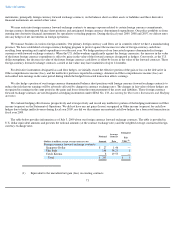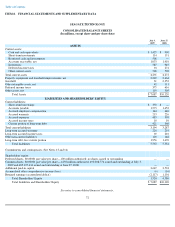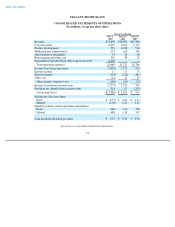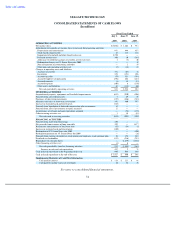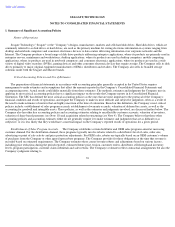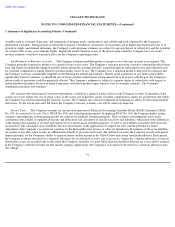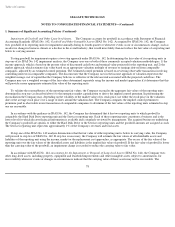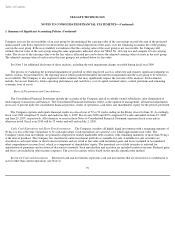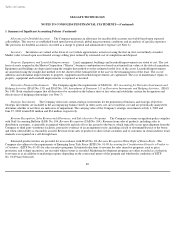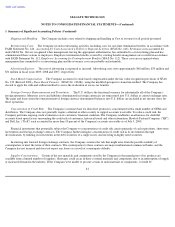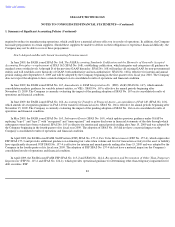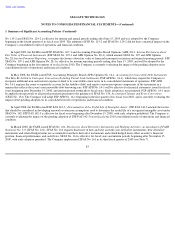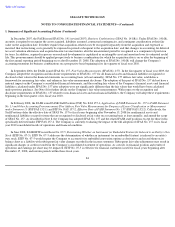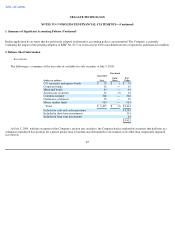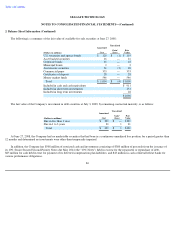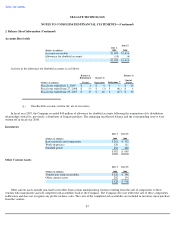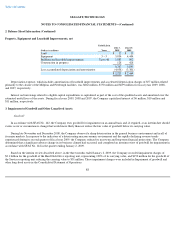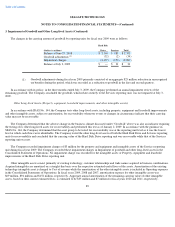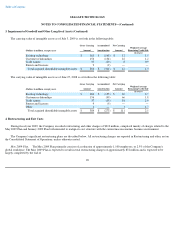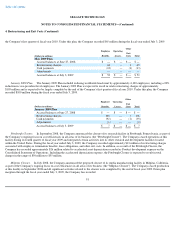Seagate 2008 Annual Report Download - page 83
Download and view the complete annual report
Please find page 83 of the 2008 Seagate annual report below. You can navigate through the pages in the report by either clicking on the pages listed below, or by using the keyword search tool below to find specific information within the annual report.
Table of Contents
SEAGATE TECHNOLOGY
NOTES TO CONSOLIDATED FINANCIAL STATEMENTS—(Continued)
1. Summary of Significant Accounting Policies (Continued)
Shipping and Handling. The Company includes costs related to shipping and handling in Cost of revenue for all periods presented.
Restructuring Costs. The Company records restructuring activities, including costs for one-time termination benefits, in accordance with
FASB Statement No. 146 , Accounting for Costs Associated with Exit or Disposal Activities (SFAS No. 146). Severance costs accounted for
under SFAS No. 146 are recognized when management, having the appropriate authorization, has committed to a restructuring plan and has
communicated those actions to employees. Employee termination benefits covered by existing benefit arrangements are recorded in accordance
with FASB Statement No. 112, Employers' Accounting for Postemployment Benefits (SFAS No. 112). These costs are recognized when
management has committed to a restructuring plan and the severance costs are probable and estimable.
Advertising Expense. The cost of advertising is expensed as incurred. Advertising costs were approximately $48 million, $55 million and
$51 million in fiscal years 2009, 2008 and 2007, respectively.
Stock-Based Compensation. The Company accounts for stock-based compensation under the fair value recognition provisions of SFAS
No. 123 (Revised 2004),
Share-Based Payment , (SFAS No. 123(R)), using the modified-prospective-transition method. The Company has
elected to apply the with-and-without method to assess the realization of excess tax benefits.
Foreign Currency Remeasurement and Translation. The U.S. dollar is the functional currency for substantially all of the Company's
foreign operations. Monetary assets and liabilities denominated in foreign currencies are remeasured into U.S. dollars at current exchange rates.
The gains and losses from the remeasurement of foreign currency denominated balances into U.S. dollars are included in net income (loss) for
those operations.
Concentration of Credit Risk. The Company's customer base for disk drive products is concentrated with a small number of OEMs and
distributors. The Company does not generally require collateral or other security to support accounts receivable. To reduce credit risk, the
Company performs ongoing credit evaluations on its customers' financial condition. The Company establishes an allowance for doubtful
accounts based upon factors surrounding the credit risk of customers, historical trends and other information. Hewlett-Packard Company ("HP")
and Dell, Inc. ("Dell") each accounted for more than 10 percent of the Company's accounts receivable as of July 3, 2009.
Financial instruments that potentially subject the Company to concentrations of credit risk consist primarily of cash equivalents, short-term
investments and foreign exchange contracts. The Company further mitigates concentrations of credit risk in its investments through
diversification, by limiting its investments in the debt securities of a single issuer, and investing in highly rated securities.
In entering into forward foreign exchange contracts, the Company assumes the risk that might arise from the possible inability of
counterparties to meet the terms of their contracts. The counterparties to these contracts are major multinational commercial banks, and the
Company has not incurred and does not expect any losses as a result of counterparty defaults.
Supplier Concentration. Certain of the raw materials and components used by the Company in the manufacture of its products are
available from a limited number of suppliers. Shortages could occur in these essential materials and components due to an interruption of supply
or increased demand in the industry. If the Company were unable to procure certain of such materials or components, it would be
81


